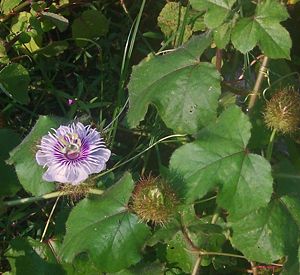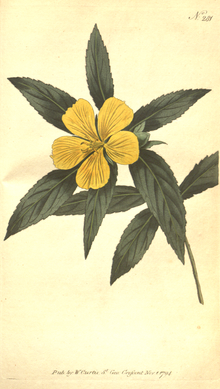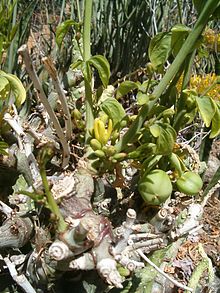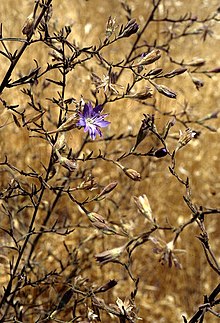Passion Flower Family
| Passion Flower Family | ||||||||||||
|---|---|---|---|---|---|---|---|---|---|---|---|---|

|
||||||||||||
| Systematics | ||||||||||||
|
||||||||||||
| Scientific name | ||||||||||||
| Passifloraceae | ||||||||||||
| Yuss. ex Roussel |
The passion flower family (Passifloraceae) are a family of plants within the order of the Malpighia-like (Malpighiales). The genera of the former families of the Malesherbiaceae and Turneraceae have also been part of the Passifloraceae family since 2009. The family Passifloraceae sl is distributed worldwide in the tropics and subtropics , with a focus on Africa and the Neotropics , few species occur in the temperate areas.
description





According to molecular genetic data, the scope of the Passifloraceae family has been expanded. Morphologically, the subfamilies differ greatly, their characteristics see there Malesherbioideae , Passifloroideae , Turneroideae .
Vegetative characteristics
The species of the Passifloraceae sl family can be herbaceous or woody plants. The plant parts of many species have an unpleasant smell. In many species, colleters (glandular emergences ) and extra-floral nectaries are present.
The alternate and spirally arranged leaves are often divided into petioles and leaf blades. Often glands are present on the foliage leaves. The stomata are paracytic.
Generative characteristics
The hermaphrodite flowers are radially symmetrical with a double flower envelope . Sepals and petals have grown together to form a tube. The scars are dry.
The seed coat is furrowed. The durable endosperm is oily.
The basic chromosome number is x = mostly 7, rarely 5 or 7.
use
The berries of some species of the subfamily Passifloroideae are eaten or juice is extracted from them ( passion fruit / maracuja , grenadilla , barbadine , curuba ).



Systematics
The Passifloraceae family was first published under the name "Passifloreae" in 1806 by Antoine Laurent de Jussieu in Henri François Anne de Roussel : Flore du Calvados , 2nd edition, 2, page 334 and the name Passifloraceae by Antoine Laurent de Jussieu in Karl Sigismund Kunth : Nova genera et species plantarum quas in peregrinatione ad plagam aequinoctialem orbis novi collegerunt Bonpland et Humboldt not until 1817. The type genus is Passiflora L.
The relationship of the Malesherbiaceae, Turneraceae and Passifloraceae families. st. were controversial. In 2009 APG III incorporated the genera of the former families of the Malesherbiaceae and Turneraceae into the family of Passifloraceae s. l. Even in publications in 2009 and afterwards in Conservative works, these three families remained separate. The scope of the family Passifloraceae sl with the species of the former families Malesherbiaceae and Turneraceae and the position within the order of the Malpighiales was confirmed in 2016 by the Angiosperm Phylogeny Group in APG IV. Synonyms for Passifloraceae Juss. ex Roussel nom. cons. are since 2009: Malesherbiaceae D.Don , Modeccaceae Horan. , Paropsiaceae Dumort. , Piriquetaceae Martynov , Smeathmanniaceae Perleb , Turneraceae Kunth ex DC.
The Passifloraceae sl family has been divided into three subfamilies with a total of about 27 genera since 2009:
- Subfamily Malesherbioideae Burnett (Syn .: Malesherbiaceae D.Don ): It contains only one genus (see main article ):
- Malesherbia Ruiz & Pav. (Syn .: Gynopleura Cav. ): The 24 to 27 species are distributed in South America only in the Andes .
- Subfamily Passifloroideae Burnett : It is divided into two tribes and contains a total of 16 genera with about 705 species (see main article ).
- Subfamily Turneroideae Eaton (Syn .: Piriquetaceae Martynov , Turneraceae DC. ): It contains about ten genera with over 200 species. Most of the species are found in the New World , but the greatest variety of genera are in the Old World (see main article ).
swell
- The family of Passifloraceae s. l. at the AP website . (Sections Description and Systematics)
Individual evidence
- ↑ a b c d e f g h i j k The family of the Passifloraceae s. l. at the AP website . last accessed on August 18, 2018
- ↑ a b Passifloraceae at Tropicos.org. Missouri Botanical Garden, St. Louis, accessed August 15, 2018.
- ↑ a b An update of the Angiosperm Phylogeny Group classification for the orders and families of flowering plants: APG III , in Botanical Journal of the Linnean Society , 2009, pp. 105-121.
- ↑ The Angiosperm Phylogeny Group: An update of the Angiosperm Phylogeny Group classification for the orders and families of flowering plants: APG IV. In: Botanical Journal of the Linnean Society , Volume 181, 2016, pp. 1-20. doi : 10.1111 / boj.12385
- ^ Passifloraceae in the Germplasm Resources Information Network (GRIN), USDA , ARS , National Genetic Resources Program. National Germplasm Resources Laboratory, Beltsville, Maryland. Retrieved August 12, 2018.
- ↑ Description of the Passifloraceae family s. st. at DELTA by L. Watson & MJ Dallwitz still in the old scope. (Section description of the family in the old scope)
- ^ T. Nunes, 2009: Neotropical Passifloraceae. In: W. Milliken, B. Klitgård, A. Baracat: Neotropikey - Interactive key and information resources for flowering plants of the Neotropics. (Section description of the family in the old scope)
- ↑ Mats Thulin, Sylvain G. Razafimandimbison, Paul Chafe, Nahid Heidari, Anneleen Kool, Joel S. Shore: Phylogeny of the Turneraceae clade (Passifloraceae sl): Trans-Atlantic disjunctions and two new genera in Africa. In: Taxon , Volume 61, Issue 2, 2012, pp. 308–323. Full text PDF.
Web links
- Passifloraceae at Tropicos.org. In: Flora Mesoamericana . Missouri Botanical Garden, St. Louis
- Passifloraceae at Tropicos.org. In: Flora de Nicaragua . Missouri Botanical Garden, St. Louis
- Passifloraceae at Tropicos.org. In: IPCN Chromosome Reports . Missouri Botanical Garden, St. Louis
- Passifloraceae at Tropicos.org. In: Catalog of the Vascular Plants of Madagascar . Missouri Botanical Garden, St. Louis
further reading
- Robert Hegnauer : Chemotaxonomie der Pflanzen - An overview of the distribution and the systematic importance of plant substances , Basel 1969, ISBN 978-3-0348-9391-6 . doi : 10.1007 / 978-3-0348-7985-9 Passifloraceae s. st. on pp. 293-298 and Malesherbiaceae on pp. 22-23.